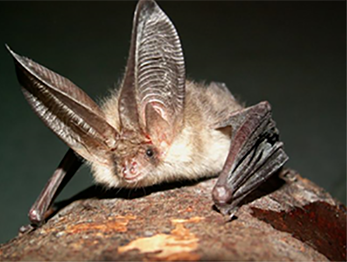The U.S. Fish and Wildlife Service (USFWS) expects to provide a decision on the listing of the Northern Long-eared Bat (Myotis septentrionalis) as an endangered species throughout its range by early April of this year. This listing has the potential to affect development projects throughout Virginia and Maryland where forests are present. As always, WSSI stands ready to guide projects past this potential new hurdle.
|
|

|
Northern Long-Eared Bat1
|
|
|
Background and regulatory actions to date:
The northern long-eared bat was formerly common and widespread throughout the eastern and central United States. Populations of this species (as well as other bat species) have declined dramatically since the discovery of white-nose syndrome (a fatal fungus) in bats in New York in 2006. As a result of white-nose syndrome, populations of northern long-eared bat have declined by 99 percent. The USFWS first proposed to list the northern long-eared bat as federally endangered in October 2013 and requested comments from stakeholders and the public regarding the proposed listing at that time. |
|
Comments received by the USFWS indicate that some stakeholders (including State Natural Resource Agencies) believe that there is not enough scientific data to support the finding that the northern long-eared bat should be listed as either threatened or endangered. Specifically, commenters have noted that the species populations have not declined as much as reported by the USFWS (due to a lack of complete survey data), and that white nose syndrome may no longer be spreading and affecting species as rapidly and detrimentally as it was initially. Given these comments, it is possible that the USFWS may choose not to list the northern long-eared bat. USFWS is expected to issue a final ruling in early April. |
|
Northern long-eared bat life history:
The northern long-eared bat occupies two types of habitats during the year. From late September to early April, the northern long-eared bat hibernates in caves, abandoned mines, and occasionally artificial structures such as railroad tunnels. The remainder of the year it forages for insects in forested settings, roosting alone or in colonies of 30 to 60 bats underneath bark, in cavities, or in other crevices of live or dead trees (and occasionally barns and sheds). Typically, these summer roost sites are within 50 miles of the winter hibernacula. |
|
What does this mean to a land owner?
If the northern long-eared bat becomes listed by the USFWS, it is likely that most forested sites in the region will need to be surveyed to determine if bats occupy summer habitat on those sites. If it is determined that northern long-eared bat are present or could be present on the site, agencies will likely impose time of year restrictions for tree clearing activities. In Virginia, these are expected to be from April 15 to September 15. Note that the need for surveys or restrictions would only occur in instances where federal actions are being requested, such as wetland permits, federal funding, federal tax credits, or FEMA map revisions. |
|

|
Davey staff assessing a bat collected during a bat survey
|
|
|
WSSI has been tracking this proposed listing for years and stands ready to provide surveys and work with land owners to move projects forward that may be affected by the northern long-eared bat. Please contact Ben Rosner or Mark Headly if you have any questions regarding this species and its proposed listing. |
|
1Photo credit: http://featuredcreature.com/wp-content/uploads/2012/10/Brown+long-eared2.jpg |